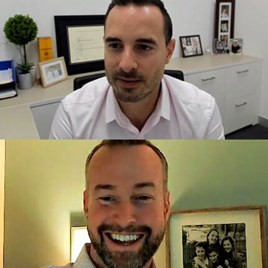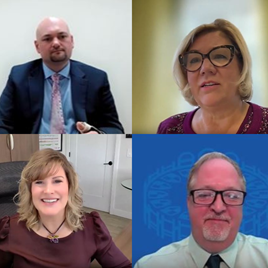May 01 2023 / Round the Table Magazine
Reimagine digital conversations
Topics Covered
Even before the COVID pandemic pushed much of the work world into home offices and video conferencing, 70% of our business communication already was electronic. Fewer face-to-face interactions led to the loss of being able to read body language cues and contributed to overthinking emails, which resulted in more misunderstandings and anxiety within work teams.
What was implicit through nonverbal body language cues must now be explicit in digital body language, said Erica Dhawan, speaker, author and an expert on collaboration and digital teamwork. Everyone has a digital personality that can either help or hurt a relationship. That is why reading digital messages carefully is the new listening, and writing those messages clearly is the new empathy.
For example, she shares a true story about Sara who emails her colleague John: “Quick thought, what do you think of this idea for the presentation?” What she really means is “I have a great idea, but it’s not fully flushed out. I’d like to get your thoughts.” John is reading the email after a long day of Zoom meetings and thought the presentation was finished. He writes back, “How does this fit in? It doesn’t seem like you thought this through.” What he really meant to write is that Sara is closer to the work than he is, so he needed more context from her. What could have been a 15-minute conversation turned into a stressful exercise of back-and-forth emails over the next several hours.
Teams don’t need more communication. They need what Dhawan calls “connectional intelligence” to eliminate messaging inefficiency and bring insights together in the right way. Harnessing the power of relationships and networks can drive breakthrough innovation and business results. Dhawan breaks her connection model into the four laws of digital body language:
1. Value visibly
- Respect people’s time. Have a clear agenda for meetings, set the tone in the first few minutes, and never, ever reschedule five minutes before the start time or fail to show up without any advance notice.
- Acknowledge individual differences by understanding the attributes of introverts and extroverts. Introverts tend to communicate better by writing rather than speaking and prefer open lines of communication outside of meetings. One of Dhawan’s clients distributes an agenda before the virtual meeting. Invitees can submit their comments beforehand to be published in the chat section and included, usually as the starting point in the discussion. “That brings out the introverts and gets rid of groupthink,” Dhawan said. Extroverts like regular face-to-face and video meetings and sometimes need a meeting moderator or virtual hand-raising to foster their engagement. Make room for both personalities.
- Practice radical recognition. The reason why employees voluntarily resigned from their jobs en masse during the pandemic and triggered the “great resignation” is because they received no “great recognition” from their former employers, Dhawan said. Find ways to recognize each individual and deliver according to their preferences. This includes knowing communication preferences regarding phone, email, text and in-person meetings, and frequency of messaging. These preferences can apply to both staff and clients.
The ‘great resignation’ is because they received no ‘great recognition’ from their former employers.
—Erica Dhawan
2. Communicate carefully
- Read messages thoughtfully and write clearly. If someone asks, “Do you want to speak Wednesday or Thursday?” responding “Yes” is not clear.
- Prioritize “maniacal clarity” over brevity. If you ask for something, identify the ask, the priority level, who needs to be involved and the delivery date.
- Create norms for email. People on the “To” line need to respond. People on the “CC” line don’t need to. The subject line should identify what you need. And labels like 2H (two hours) or 4D (four days) can help communicate timelines.
- Choose the right channel. Not all messages make sense in every place (email, text, social media, etc.). Be deliberate and purposeful in what you say and where you say it.
3. Collaborate confidently
- Match expectations to execution. If you say you’ll get back to someone soon, don’t make them chase you for two weeks. Don’t ask for something tomorrow morning if the request goes out at 10 p.m. Give trust and earn it as well.
- Encourage people to participate in problem solving. Dhawan cited one company that created committees to devise better processes and found administrative assistants, who might commonly not be asked for ideas like this, to be the best source of solutions.
- Maximize meeting effectiveness by asking the following questions: Should it really be a meeting? Did I get everyone involved in the first five minutes? Can I schedule it to be a shorter meeting? Did we have a clear meeting purpose, objectives or agenda in the meeting invite? Did I define success at the start of the meeting? Did I include the remote attendees in my hybrid meetings? Did I have a clear notetaker sharing next steps right after the meeting? Did I record the meeting if it’s helpful to attendees who need to stay in the loop?
Give trust and earn it as well.
4. Trust totally
- Give people the benefit of the doubt. That means trusting that people understand you, and that you can show vulnerabilities as well.
- Create watercooler moments for informal social communication. Consider asking questions like what’s one approach we haven’t heard? What have we missed? What’s a piece of bad news I don’t want to hear? Including those queries in the agenda allows attendees to prepare answers in advance. Other queries could be: If we were devil’s advocates, what would we say? or What’s one way we can improve the next meeting?
Transform tough talk into constructive moments
There’s only one rule when you receive negative feedback or criticism: Ask for more.
That was the advice a mentor gave Sarita Maybin when she was a graduate student. Years later, when she worked at a university supervising a college department, she asked a staffer what he thought they could do to improve the department. He responded: “Well, you could be a better supervisor.”
The evil twin in her wanted to write him up for insubordination, but she recalled her mentor’s advice and asked, “Can you elaborate? Give me an example. What do you suggest?” She learned that her staff didn’t know how she thought they were performing on a day-to-day basis, and he suggested maybe during their one-on-one meetings, she could tell them one thing they’re doing well and one thing they need to work on.
Maybin, a speaker, author and expert on transforming difficult conversations into constructive communication, cringes at the thought of what the outcome could have been if she gave into her first impulse. Her follow-up questions fostered collaboration and a better working relationship, but she cautioned that using all the wonderful phrases in the world won’t help unless “we get our mindset right and look at the situation or person in a positive way, even if we already know some stuff about them.” That means adjusting from seeing someone who is nitpicky as detail oriented, a pest as persistent, a diva as confident or an impulsive person as spontaneous.
This pre-conversation mind shift can extend to how you talk to co-workers, your boss and clients. Rather than saying phrases that raise defense shields like “You need to …,” “You better …” or “You should have …,” try solution-seeking words like “I would appreciate if …,” “It would be helpful if …” or “Let’s see how we can make this work.”
In essence, Maybin is preaching, “Don’t say it mean.” Among her list of 50 phrases that help people work together better include:
- How can we resolve this?
- What do you need from me?
- Help me understand.
- So what you’re saying is …
- When you do _____________, the way it affects the staff is _____________.
- I’m concerned that …
- Would it be possible to …
- I’d like your thoughts on …



![Elevating your financial advisory journey: how the right mentor can propel your success to new heights [Surabhi Chaudhary]](https://www.mdrt.org/globalassets/digizuite/32702-en-updated_-india_video-interview_surabhi-chaudhari-thumbnail.png?height=268&crop=0,0,268,268)

![Beyond finance: Individuals outside the financial profession every financial advisor should learn from [Nirmal Debnath]](https://www.mdrt.org/globalassets/digizuite/32634-en-india_written-interview_nirmal-debnath-thumbnail.jpeg?height=268&crop=0,0,268,268)
![How to tailor financial advice to fit the unique needs and goals of your clients [Merryl Baptista]](https://www.mdrt.org/globalassets/digizuite/32635-en-india_written-interview_merryl-baptista-thumbnail.jpeg?height=268&crop=0,0,268,268)
![Anticipating the financial needs of Gen Z clients and advising prospects towards adequate insurance cover [Komal Atal]](https://www.mdrt.org/globalassets/digizuite/32632-en-india_written-interview_komal-attal-thumbnail.jpeg?height=268&crop=0,0,268,268)
![Enhancing your offline persona through cultivating an online presence: Tips and strategies [Khushboo Bajaja More]](https://www.mdrt.org/globalassets/digizuite/32630-en-india_written-interview_khushboo-bajaj-more-thumbnail.jpeg?height=268&crop=0,0,268,268)
![A former flight attendant's sky-high client servicing standards [Beth Daffodil Uy Tan]](https://www.mdrt.org/globalassets/digizuite/32577-en-ph-_video-interview_a-former-flight-attendant's-sky-high-client-servicing-standards_daffodil-tan-thumbnail.png?height=268&crop=0,0,268,268)



![Overcoming a financial advisor’s internal self-doubts [Cedrick Cruz]](https://www.mdrt.org/globalassets/digizuite/32509-en-ph_written-interview_-handling-a-financial-advisors-self-doubts-cedrick-cruz-thumbnail.jpg?height=268&crop=0,0,268,268)